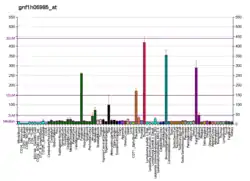| PPP1R14C | |||||||||||||||||||||||||||||||||||||||||||||||||||
|---|---|---|---|---|---|---|---|---|---|---|---|---|---|---|---|---|---|---|---|---|---|---|---|---|---|---|---|---|---|---|---|---|---|---|---|---|---|---|---|---|---|---|---|---|---|---|---|---|---|---|---|
| Identifiers | |||||||||||||||||||||||||||||||||||||||||||||||||||
| Aliases | PPP1R14C, CPI17-like, KEPI, NY-BR-81, protein phosphatase 1 regulatory inhibitor subunit 14C | ||||||||||||||||||||||||||||||||||||||||||||||||||
| External IDs | OMIM: 613242 MGI: 1923392 HomoloGene: 12805 GeneCards: PPP1R14C | ||||||||||||||||||||||||||||||||||||||||||||||||||
| |||||||||||||||||||||||||||||||||||||||||||||||||||
| |||||||||||||||||||||||||||||||||||||||||||||||||||
| |||||||||||||||||||||||||||||||||||||||||||||||||||
| |||||||||||||||||||||||||||||||||||||||||||||||||||
| |||||||||||||||||||||||||||||||||||||||||||||||||||
| Wikidata | |||||||||||||||||||||||||||||||||||||||||||||||||||
| |||||||||||||||||||||||||||||||||||||||||||||||||||
Protein phosphatase 1 regulatory subunit 14C is an enzyme that in humans is encoded by the PPP1R14C gene.[5][6]
References
- 1 2 3 GRCh38: Ensembl release 89: ENSG00000198729 - Ensembl, May 2017
- 1 2 3 GRCm38: Ensembl release 89: ENSMUSG00000040653 - Ensembl, May 2017
- ↑ "Human PubMed Reference:". National Center for Biotechnology Information, U.S. National Library of Medicine.
- ↑ "Mouse PubMed Reference:". National Center for Biotechnology Information, U.S. National Library of Medicine.
- ↑ Ceulemans H, Stalmans W, Bollen M (Apr 2002). "Regulator-driven functional diversification of protein phosphatase-1 in eukaryotic evolution". BioEssays. 24 (4): 371–81. doi:10.1002/bies.10069. PMID 11948623.
- ↑ "Entrez Gene: PPP1R14C protein phosphatase 1, regulatory (inhibitor) subunit 14C".
Further reading
- Gerhard DS, Wagner L, Feingold EA, et al. (2004). "The status, quality, and expansion of the NIH full-length cDNA project: the Mammalian Gene Collection (MGC)". Genome Res. 14 (10B): 2121–7. doi:10.1101/gr.2596504. PMC 528928. PMID 15489334.
- Ota T, Suzuki Y, Nishikawa T, et al. (2004). "Complete sequencing and characterization of 21,243 full-length human cDNAs". Nat. Genet. 36 (1): 40–5. doi:10.1038/ng1285. PMID 14702039.
- Mungall AJ, Palmer SA, Sims SK, et al. (2003). "The DNA sequence and analysis of human chromosome 6". Nature. 425 (6960): 805–11. Bibcode:2003Natur.425..805M. doi:10.1038/nature02055. PMID 14574404.
- Scanlan MJ, Gout I, Gordon CM, et al. (2003). "Humoral immunity to human breast cancer: antigen definition and quantitative analysis of mRNA expression". Cancer Immun. 1: 4. PMID 12747765.
- Strausberg RL, Feingold EA, Grouse LH, et al. (2003). "Generation and initial analysis of more than 15,000 full-length human and mouse cDNA sequences". Proc. Natl. Acad. Sci. U.S.A. 99 (26): 16899–903. Bibcode:2002PNAS...9916899M. doi:10.1073/pnas.242603899. PMC 139241. PMID 12477932.
- Liu QR, Zhang PW, Zhen Q, et al. (2002). "KEPI, a PKC-dependent protein phosphatase 1 inhibitor regulated by morphine". J. Biol. Chem. 277 (15): 13312–20. doi:10.1074/jbc.M107558200. PMID 11812771.
- Connor JH, Weiser DC, Li S, et al. (2001). "Growth arrest and DNA damage-inducible protein GADD34 assembles a novel signaling complex containing protein phosphatase 1 and inhibitor 1". Mol. Cell. Biol. 21 (20): 6841–50. doi:10.1128/MCB.21.20.6841-6850.2001. PMC 99861. PMID 11564868.
This article is issued from Wikipedia. The text is licensed under Creative Commons - Attribution - Sharealike. Additional terms may apply for the media files.





